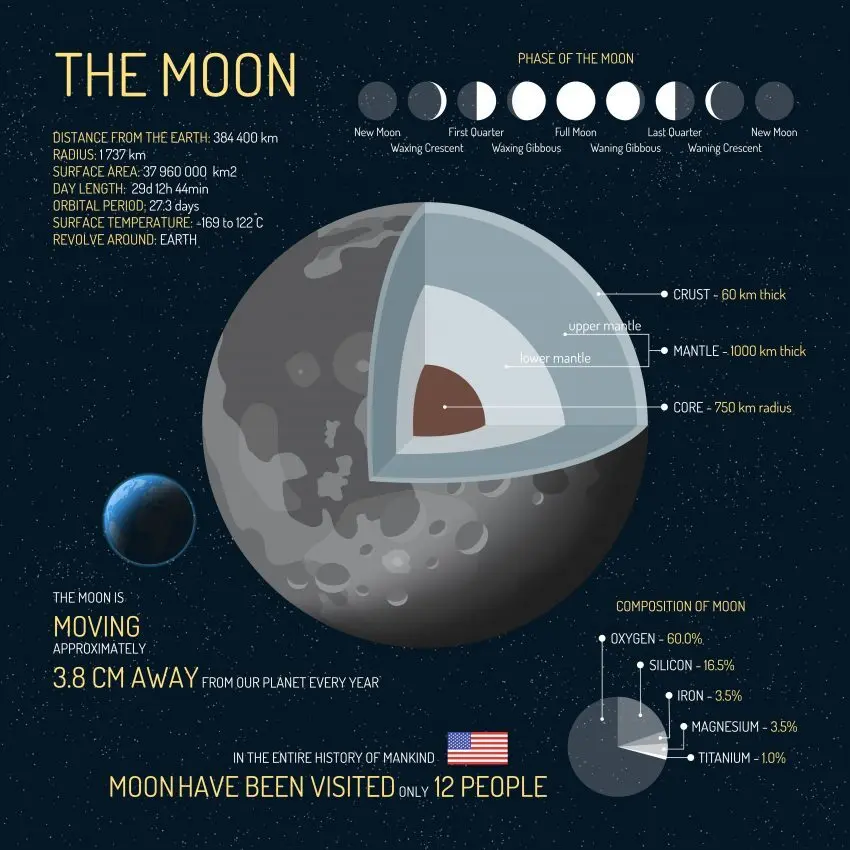Important Facts For Prelims
Time Zone for Moon
- 13 Apr 2024
- 6 min read
Why in the News?
Recently, the European Space Agency is planning a universal timekeeping system for the moon.
What is Timekeeping on the Moon?
- About:
- The Moon (the only natural Satellite of earth) has its own day and night cycle, which lasts about 29.5 Earth days.
- Currently, the time on the Moon is measured using Universal Time Coordination (UTC), which is the same timekeeping system used on the Earth.
- 'Coordinated Lunar Time' (LTC) will be the unified time standard for the Moon.
- To decide LTC, there will be a need to place at least three atomic clocks on the lunar surface that will tick at the Moon’s natural pace, and whose output will be combined by an algorithm to generate a more accurate virtual timepiece.
- Need of LTC:
- LTC will provide a time-keeping benchmark for lunar spacecraft and satellites that require extreme precision for their missions.
- It will also synchronise the communication between satellites, astronauts, bases and the Earth.
- Because the Moon’s day is much longer than Earth’s day, it would be difficult to use UTC for day-to-day activities on the Moon.
- The International Space Station, being in low Earth orbit, will continue to use coordinated universal time (UTC).
- Moon has a lesser gravitational force than Earth. Compared to Earth, time on the Moon moves 58.7 microseconds quicker every day.
- An atomic clock on the moon will tick at a different rate than a clock on Earth.
- To address this issue, researchers have proposed creating a lunar time zone that would be based on the Moon’s day and night cycle.
- This would make it easier for lunar settlers to keep track of time and coordinate activities.
- Having a lunar time zone would also make it easier for researchers to conduct experiments and collect data on the Moon.
- It would also help to prevent confusion and errors that could arise from using different timekeeping systems on Earth and the Moon.
- Challenges:
- Implementing a unified time standard for the Moon requires extensive global cooperation and consensus on the scientific intricacies of timekeeping.
What is Universal Time Coordinated (UTC)?
- Universal Time Coordinated (UTC) is a time standard used to keep time consistent around the world.
- UTC is based on International Atomic Time (TAI), which is maintained by atomic clocks around the world.
- It is the primary time standard used by many countries, international organisations, and scientific research institutions.
- UTC is expressed as a 24-hour clock and is used to indicate the time offset from Coordinated Universal Time (UTC+0).
- Time zones are defined as an offset from UTC, with some time zones being ahead of UTC (UTC+1, UTC+2, etc.) and others being behind UTC (UTC-1, UTC-2, etc.).
- UTC is adjusted periodically to account for changes in the Earth’s rotation, which can cause variations in the length of a day.
- These adjustments are made by adding leap seconds to UTC, which helps keep the time standard synchronised with the Earth’s rotation.
What are Atomic Clocks?
- An atomic clock, is a clock, known for its exceptional accuracy, and functions by utilising specific resonance frequencies of atoms, typically cesium or rubidium.
- In atomic time, a second is defined as the period in which a caesium atom vibrates 9,192,631,770 times.
- It was invented in 1955 by Louise Essen.
- The extreme precision levels of the atomic clocks can be interpreted by the fact that they will lose one second approximately every 100 million years.
- Currently, atomic clocks in India are operational in Ahmedabad and Faridabad.
Read more: 2 Time Zones in India
UPSC Civil Service Examination, Previous Year Questions(PYQs)
Q.1 Selene-1, the lunar orbiter mission belongs to which one of the following? (2008)
(a) China
(b) European Union
(c) Japan
(d) USA
Ans: (c)
Q.2 What is the purpose of the US Space Agency’s Themis Mission, which was recently in the news? (2008)
(a) To study the possibility of life on Mars
(b) To study the satellites of Saturn
(c) To study the colourful display of high latitude skies
(d) To build a space laboratory to study the stellar explosions
Ans: (c)
Q. Which one of the following planets has largest number of natural satellites or moons? (2009)
(a) Jupiter
(b) Mars
(c) Saturn
(d) Venus
Ans: (a)
Q. Tides occur in the oceans and seas due to which among the following? (2015)
- Gravitational force of the Sun
- Gravitational force of the Moon
- Centrifugal force of the Earth
Select the correct answer using the code given below:
(a) 1 only
(b) 2 and 3 only
(c) 1 and 3 only
(d) 1, 2 and 3
Ans: (d)







